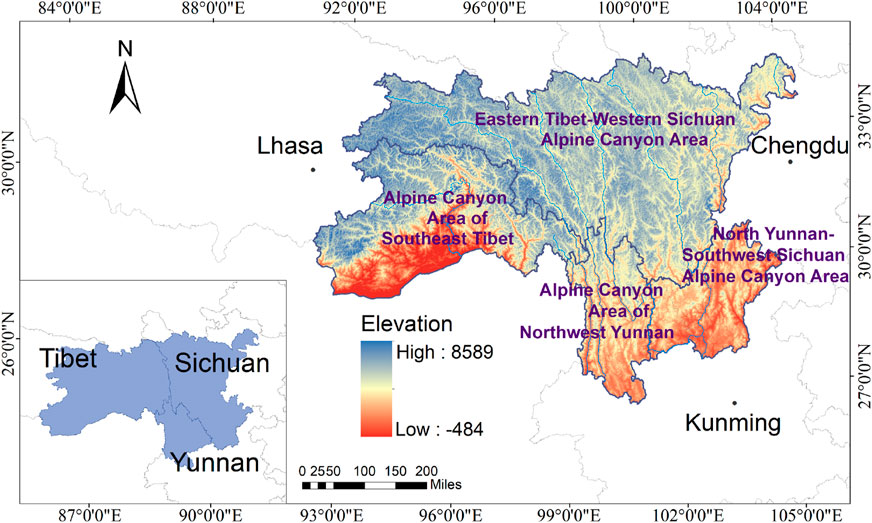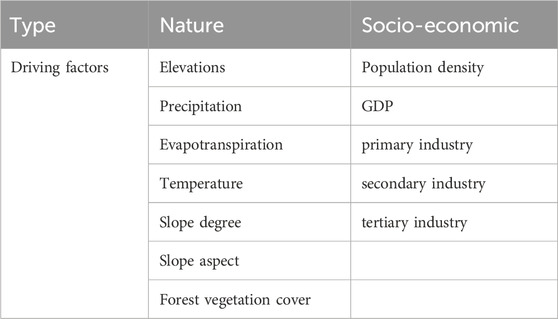- 1School of Soil and Water Conservation, Beijing Forestry University, Beijing, China
- 2Institute of Tibetan Plateau Research, Chinese Academy of Sciences, Beijing, China
The Alpine Canyon Area of Southwest China represents a region of ecological and cultural significance, where multi-ethnic communities rely heavily on ecosystem services for sustenance, including food, water, and other vital resources. To systematically evaluate these dependencies, this study utilized multi-source datasets to quantify the spatiotemporal patterns of four key ecosystem services in the region: carbon sequestration food supply (FS), water yield (WY), and soil conservation (SR). Spearman correlation analysis, geographically weighted regression, and the geographic detector method were employed to analyze trade-offs and synergies among these ecosystem services and explore their driving mechanisms. The results indicated: (1) The four ecosystem services in the study area exhibited significant spatiotemporal heterogeneity. (2) During the study period, the synergies were observed between CS-WY, CS-SR, and WY-SR, highlighting a particularly strong synergy for WY-SR. Conversely, trade-offs were observed for CS-FS, FS-WY, and FS-SR, with the strongest trade-off occurring between food supply and water yield. (3) The trade-offs and synergies among ecosystem services in the region were significantly influenced by a combination of natural and socio-economic factors, with elevation, slope degree, temperature, and population density playing pivotal roles. Among all ecosystem services pairs, the interaction between elevation and other influencing factors represented the most critical driver combination. This study highlights the importance of ecosystem services in multi-ethnic regions, provides insights into ecosystem services trade-offs and synergies, and offers scientific support for regional ecological management.
1 Introduction
Ecosystem services (ESs), derived from ecosystem structures, processes, and functions, bridge ecological and social systems, ensuring ecological security, human safety, and quality of life (Fu and Yu, 2016; Reid et al., 2005; Costanza et al., 1998). Addressing the challenge of meeting humanity’s growing demand for natural resources while maintaining fundamental ecosystem functions and resilience require an in-depth understanding of the complex relationships between ESs, understanding trade-offs - where enhancing one ESs diminish another - and synergies, where multiple ESs change concurrently (Tomscha and Gergel, 2016; Tomscha et al., 2016). Optimizing the management of conflicts between multiple objectives in ecosystem services management and alleviating trade-offs between ESs are essential for ensuring the diversification of ecosystem services and high-quality regional development (Cord et al., 2017).
According to the United Nations Millennium Ecosystem Assessment, most of the global ecosystem services have experienced degradation or unsustainable use over the past half-century, posing significant threats to regional and global ecological security (Pereira et al., 2024; Tomscha et al., 2016; Reid et al., 2005). To address challenges and conflicts arising from the impacts of ecosystem services on sustainable development, interdisciplinary research in geography, ecology, and economics have increasingly focused on ESs trade-offs and synergies (Boithias et al., 2014; Peng et al., 2017). Recent studies have employed diverse methodologies to explore ESs spatial-temporal patterns and capture trade-offs/synergies across diverse regions and scales (Wang et al., 2022; Yang et al., 2024). For instance, Shifaw et al. (2024) mapped the spatial-temporal distribution of four ESs (water production, carbon-fixation, habitat quality, and soil conservation) in the Upper Qing Nile River Basin in northwestern Ethiopia to evaluate the trade-offs and synergies. Similarly, Feng et al. (2021) utilized a Bayesian probability network to analyze trade-offs and synergies in the Beijing-Tianjin-Hebei region. These studies underscored the importance of understanding trade-offs and synergies in ESs for effective regional ecological management (Hao et al., 2023). Based on this, this study aims to examine these dynamics in ESs trade-offs/synergies and identify the underlying mechanisms driving these patterns, offering actionable insights to support sustainable ecological decision-making.
The Southwest Alpine Canyon are situated in southwestern China. Over 40 snow-capped mountains exceeding 6,000 m in elevation dominate the landscape, providing freshwater for China major rivers, such as the Yangtze and Pearl Rivers. Water vapor and river runoff influenced by the Qinghai-Tibet Plateau and the Himalayas (Li, 2010; Da-ming and Xuan-juan, 2001; Daming et al., 2004). It is also a multi-ethnic settlement area, where diverse ethnic groups have developed unique cultural, religious, and customary practices, fostering ecosystem protection through traditional beliefs like “nature worship” and sacred ancestral lands (Wang et al., 2019; Lin and Gui, 2024). Settlements are concentrated in lowland areas, where water and soil cultivation, combined with natural barriers, enhance production and living spaces (Guo et al., 2023). However, rapid economic development has led to significant anthropogenic interference, resulting in resource overconsumption and ecosystem degradation (Ramyar et al., 2020; Zhang et al., 2020). Despite its ecological and cultural significance, the region remains understudied, with previous research primarily focusing on low and medium altitude areas, which differ markedly from the alpine canyon environment. Systematic evaluations of ESs are urgently needed to understand their overall characteristics, complex interactions, and the mechanisms driving trade-offs and synergies. Addressing these gaps are critical for advancing regional research, enhancing ESs value, and informing sustainable management in this unique alpine canyon area.
The Southwest Alpine Canyon exhibit significant ecological vulnerability due to its complex geological landforms, which create intricate ecosystems with low stability, poor recovery capacity, and high sensitivity to external disturbances (Ding et al., 2021; Tan et al., 2024). Key ecological challenges include degradation from soil erosion, bedrock exposure, and stone desertification (Guo et al., 2023), making water yield and soil retention particularly crucial for ecosystem management (Yahdjian et al., 2015). These processes are further exacerbated by land use changes that affect carbon sequestration services (Hall et al., 2012) and alter food supply systems, ultimately impacting regional governance and the livelihoods of ethnic minority communities dependent on these ecosystems. Based on the above, this study utilized multi-source datasets in the Southwest Alpine Canyon Area to analyze ESs. (1) The InVEST model was employed to evaluate four key ESs: carbon sequestration (CS), food supply (FS), water yield (WY), and soil conservation (SR). (2) Spearman correlation analysis and geographically weighted regression were used to reveal trade-offs, synergies, and spatial heterogeneity among these ESs. (3) The geographic detector model was applied to explore the mechanisms driving variations in ESs trade-offs and synergies. Our findings provide valuable insights for rational land use, ecological management, and the formulation of targeted strategies to ensure ecological safety in ethnic minority areas, offering guidance for the sustainable utilization of alpine canyon resources.
2 Study area and data
2.1 Study area
The Southwest Alpine Canyon Area, located in southwestern China (Figure 1), spans geographic coordinates from 24°56′N−33°09′N latitude and 91°24′E−104°15′E longitude. It encompasses three major topographic steps of China: The Transverse Mountains on the first topographic step, the Sichuan Basin on the second topographic step, and the plains in the middle and lower reaches of the Yangtze River on the third topographic step (Wang et al., 2019). The region exhibits a complex geological structure shaped by extensive tectonic movements, with landscapes ranging from mountains, hills, and plateaus to basins, canyons, river valleys, and dams, characterized by significant elevation variations (Li, 2010). The climate is diverse and vertically stratified, encompassing subtropical, temperate and cool-temperate (Lin and Gui, 2024). The water system is dense, with major rivers such as the Yarlung Zangbo, Lancang, and Jinsha Rivers flowing from northwest to southeast, forming extensive river networks (Daming et al., 2004). The region is home to a wide distribution of ethnic minorities, with nearly 30 groups, including the Yi, Pumi, Lisu, Hani, Lahu, Tibetan, and Hui, accounting for approximately 80% of the total population. This cultural diversity adds to the socio-environmental complexity of the area.
2.2 Data sources
Estimation of ESs relies on multi-source datasets (Table 1). Spatial data were primarily sourced from public databases, with additional data derived using conversion tools and formulas. Land use data for 2002, 2012, and 2022, with a spatial resolution of 30 m × 30 m, were obtained from the CLCD dataset, updated by Prof. Jie Yang and Xin Huang of Wuhan University. The dataset includes land use types such as cropland, forests, shrubs, grasslands, watersheds, snow and ice, bare ground, impervious surfaces, and wetlands (Figure 2). Meteorological data (temperature, precipitation, and evapotranspiration) were acquired from the National Earth System Science Data Center at a 1 km resolution. Elevation data, derived from a DEM, were sourced from the Geospatial Data Cloud Platform at a 30 m resolution. Plant-available water content data were obtained from the World Soil Database, jointly developed by the Food and Agriculture Organization (FAO) and the International Institute for Applied Systems Analysis (IIASA). Vegetation cover data, with a resolution of 250 m, were downloaded from the Earth Resources Data Cloud Platform. Soil data were extracted from the Harmonized World Soil Database (HWSD), with soil erodibility calculated from soil texture using the EPIC model. Socio-economic data, including population density, GDP, and primary, secondary, and tertiary industry data, were sourced from the China County Statistical Yearbook of the National Bureau of Statistics.
2.3 Methods
2.3.1 Quantification of ecosystem services
The assessment methodology employs the InVEST model, a spatially explicit tool developed by Stanford University and collaborators to evaluate how ecosystem changes influence the provision of benefits to human societies. Based on a production function approach, the InVEST model quantifies ecosystem services and supports decision-making in natural resource management by identifying priority areas for investment to enhance both human wellbeing and ecological sustainability. The specific assessment procedures and computational frameworks for four key ecosystem services, carbon sequestration, food supply, water yield, and soil conservation, are detailed in Table 2.
2.3.2 Correlation analysis
Correlation analysis can effectively reflect the direction and intensity of ESs trade-offs and synergies (Agudelo et al., 2020). Spearman correlation analysis was used to quantify variation and relationships between ESs trade-offs and synergies on the three temporal scales in 2002, 2012, and 2022. Positive correlations between ESs correspond to synergies, and negative correlations correspond to trade-offs. The formula was as follows:
2.3.3 Geographically weighted regression (GWR) model
While correlation analysis offers a general understanding of overall trade-offs and synergies, it fails to capture the spatial heterogeneity of these effects. The GWR model, a robust spatial data analysis method, addresses this limitation by accounting for the heterogeneity and non-stationarity of spatial data, surpassing traditional regression models (Kupfer and Farris, 2007). To gain deeper insights into the spatial distribution of trade-offs and synergies among ESs, the GWR model was employed to reveal their spatial variations. The calculation formula was as follows:
In the formula,
2.3.4 Geographic detector model
Geographic detector is a new statistical method for revealing the underlying mechanism driving it. Its q-statistics, which detect explanatory factors, and analyze interactions between variables, have been widely applied across natural and social sciences (Zhao et al., 2020). In this study, factor detection within the geographic detector framework was employed to explore the influence of individual factors on trade-offs and synergies among ESs, while interaction detection was used to further elucidate the interplay among these driving factors.
Factor detection quantifies the extent to which a single driver explains spatial divergence in ESs trade-offs and synergies, measured using the q-value metric. The formula was calculated as follows:
where q is the effect of the driving factor on ESs trade-offs and synergies. K = 1, … , n is the classification of this influencing factor. NK and N are the number of cells in the sub-region and the whole region, respectively. σ2K and σ2 are the variance in the Y-values in the sub-region and the whole region, respectively.
Interaction detection was conducted to assess the relationships among different factors, specifically whether their combined interactions enhance or diminish the explanatory power of trade-offs and synergies among ESs, or whether their effects operate independently. The following five types of relationships were included:
If q(A∩B)<Min(q(A), q(B)), the two factors are nonlinearly weakened.
If Min(q(A), q(B))<q(A∩B)<Max(q(A), q(B)), the one-factor nonlinearity is weakened.
If q(A∩B)>Max(q(A), q(B)), then the two factors are enhanced.
If q(A∩B) = q(A)+q(B), the two factors are independent of each other.
If q(A∩B)>q(A)+q(B), then the two factors are nonlinearly enhanced.
Building on the primary factors identified in previous studies as drivers of variation in ESs trade-offs and synergies, and considering the distinctive landscape patterns of the Southwest Alpine Canyon Area, 12 influencing factors, encompassing both natural and socio-economic dimensions, were selected for analysis (Table 3).
3 Results
3.1 Spatial and temporal patterns of ecosystem services
The four ESs of CS, FS, WY, and SR in study area exhibit distinct spatial distribution patterns (Figure 3). During the study period, low-value areas of CS were predominantly concentrated in the high-altitude alpine canyon regions of southeastern Tibet and the alpine canyon areas of eastern Tibet-western Sichuan (Figure 1). High-value areas of FS were mainly located in the southern part of the study area, particularly in the high mountain canyon regions of southeastern Yunnan-southwestern Sichuan. WY exhibited high-value areas primarily in the high-altitude alpine canyon region of southeastern Tibet, while SR high-value areas were concentrated along the edges of the high-altitude alpine canyon region in southeastern Tibet and the alpine canyon region of northwestern Yunnan. Severe soil erosion and low soil conservation efficiency are prevalent in this region. High-value areas of soil retention and water yield were primarily located in the forested regions of the southern high-altitude alpine canyon area in southeastern Tibet, where extensive vegetation coverage, effective artificial protection measures, and high water and soil retention capacities prevail. These areas experience minimal human interference and exhibit elevated levels of ESs. In contrast, low-value zones were mainly found in the high mountain canyon regions of northern Yunnan-southwestern Sichuan and northwestern Yunnan, where intensive human activities have reduced naturalness and ESs levels. Arable lands in the high mountain valley areas of northern Yunnan-western Sichuan and northwestern Yunnan were significantly influenced by anthropogenic activities, leading to enhanced crop production capacity. The study area exhibited superior carbon storage services due to the widespread distribution of forest, which enhance carbon sequestration capabilities. Conversely, low-value areas of carbon storage were primarily located in the ice and snow-covered regions of the western part of the study area.
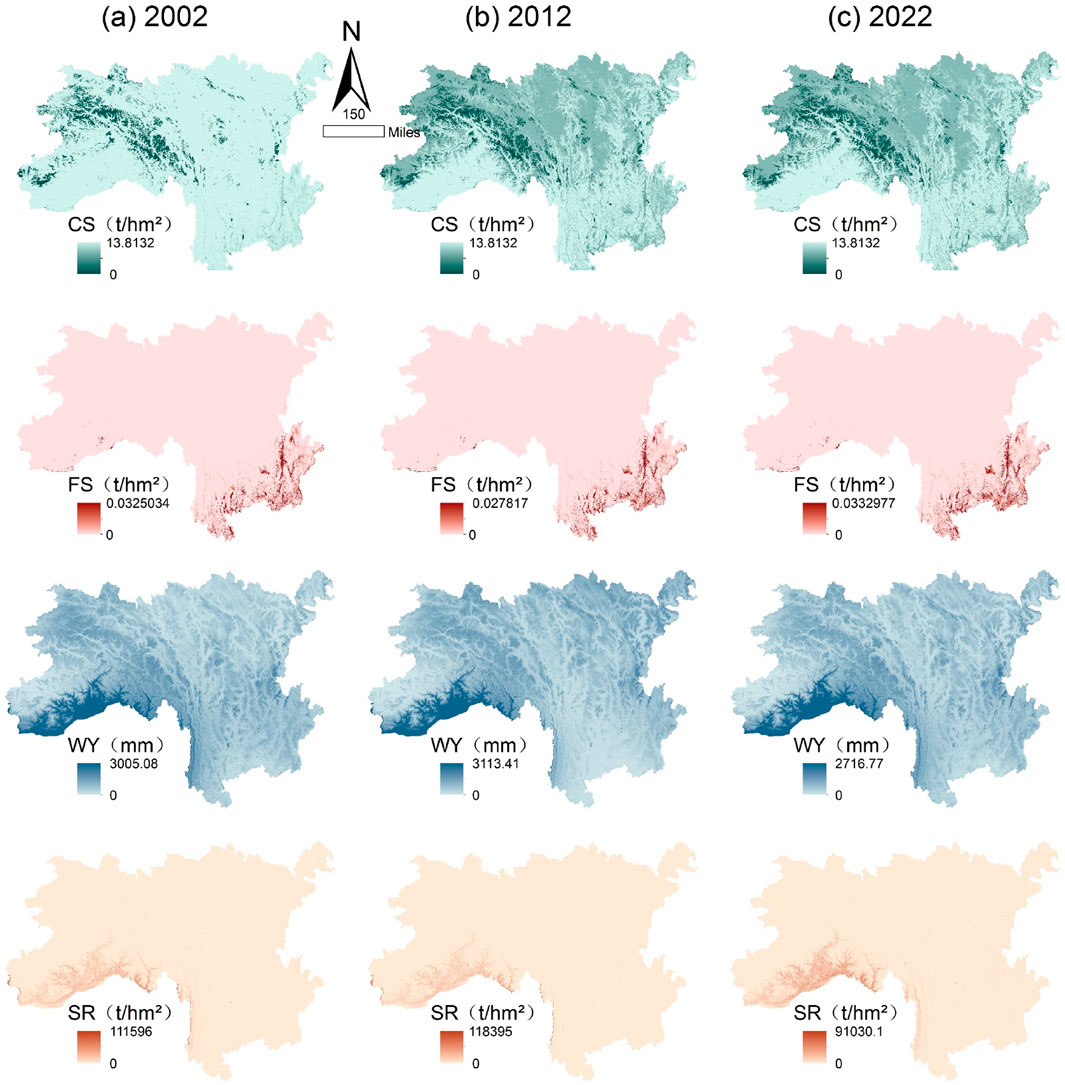
Figure 3. Spatial and temporal characteristics of ESs in the Southwest Alpine Canyon Area listed left to right as follows: (a) 2002, (b) 2012 and (c) 2022, and from top to bottom: CS, carbon sequestration; FS, food supply; WY, water yield; SR, soil conservation.
From 2002 to 2022, the degree of change in ESs is illustrated in Figure 4, with distinct patterns observed across different services. Carbon sequestration initially decreased and then increased, while both water yield and soil conservation showed a declining trend, with more pronounced changes in water production. Among all ESs, food supply demonstrated the most significant increase, showing a continuous upward trend. For the periods 2002–2012 and 2012–2022, water yield decreased by 1.14% and 6.75%, respectively, while soil conservation decreased by 1.72% and 1.63%, respectively. In contrast, food supply experienced an overall improvement, increasing by 8.46% and 10.04% during the same periods. Carbon sequestration decreased by 0.11% from 2002 to 2012 but showed a slight increase of 0.25% from 2012 to 2022.
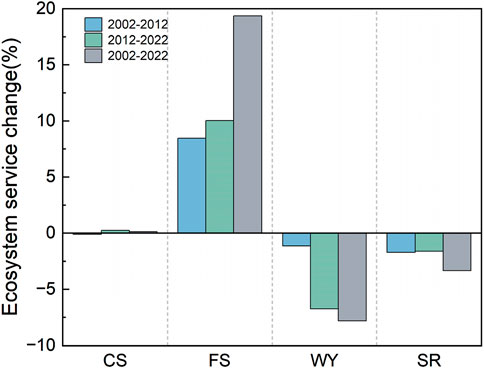
Figure 4. Changes in ESs in the southwestern alpine canyon area, 2002–2022. Note: CS, carbon sequestration; FS, food supply; WY, water yield; SR, soil conservation.
3.2 Ecosystem services trade-offs and synergies
3.2.1 Trade-offs and synergies between ecosystem services
From 2002 to 2022, the study identified trade-offs and synergistic relationships among four ecosystem services: CS, FS, WY, and SR (Figure 5). Six pairs of relationships were found, revealing significant synergistic effects for CS-WY, CS-SR, and WY-SR, highlighting a particularly strong synergy for WY-SR. Conversely, trade-off effects were observed for CS-FS, FS-WY, and FS-SR, with FS consistently exhibiting trade-offs with other ESs. The most pronounced trade-off was between FS and WY. Over the three time periods, the trade-offs between FS-WY and FS-SR initially intensified and subsequently weakened. The weakest trade-offs were recorded in 2002 (−0.44 and −0.38, respectively), while the strongest trade-offs occurred in 2012 (−0.66 and −0.56, respectively).
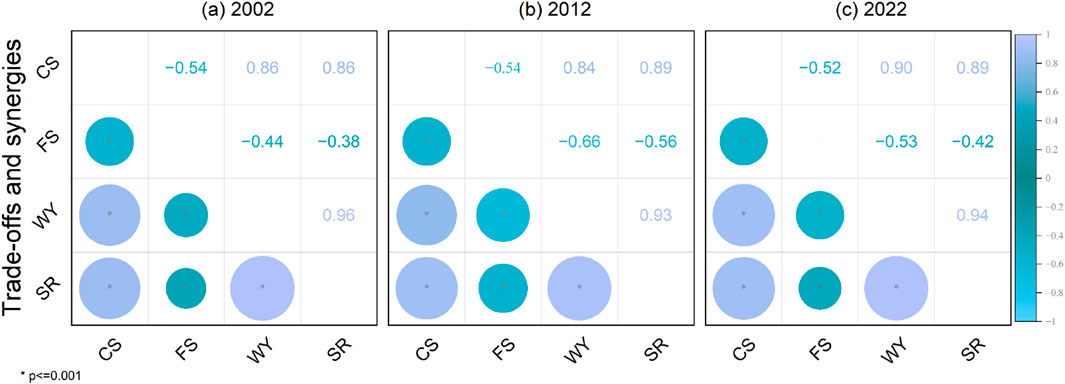
Figure 5. Trade-offs and synergies among ESs in the southwestern alpine canyon area: spearman correlation between different ecosystem services, in (a) 2002, (b) 2012, and (c) 2022. (Green indicate trade-offs, purple indicate synergies and the size of the circle indicate the strength of the correlation) Note: CS, carbon sequestration; FS, food supply; WY, water yield; SR, soil conservation.
3.2.2 Spatial heterogeneity in ecosystem services trade-offs and synergies
The study revealed significant spatial heterogeneity of trade-offs and synergies among ecosystem services (Figure 6). The spatial synergies of between FS and WY as well as between FS and SR exhibited a broad distribution, predominantly concentrated in the high-altitude alpine canyon regions of southeastern Tibet and the alpine canyon areas of eastern Tibet-western Sichuan within the western part of the study area (Figure 1). Conversely, the spatial trade-offs of between WY and SR were widely distributed across most regions in study area, excluding the northern edge of the study area, with particularly pronounced strong trade-offs observed in the alpine canyon regions of northern Yunnan-southwestern Sichuan and northwestern Yunnan. Furthermore, during the study period, a pronounced increasing trend in the spatial strong trade-offs between CS and WY, as well as between WY and SR, was consistently observed over time.
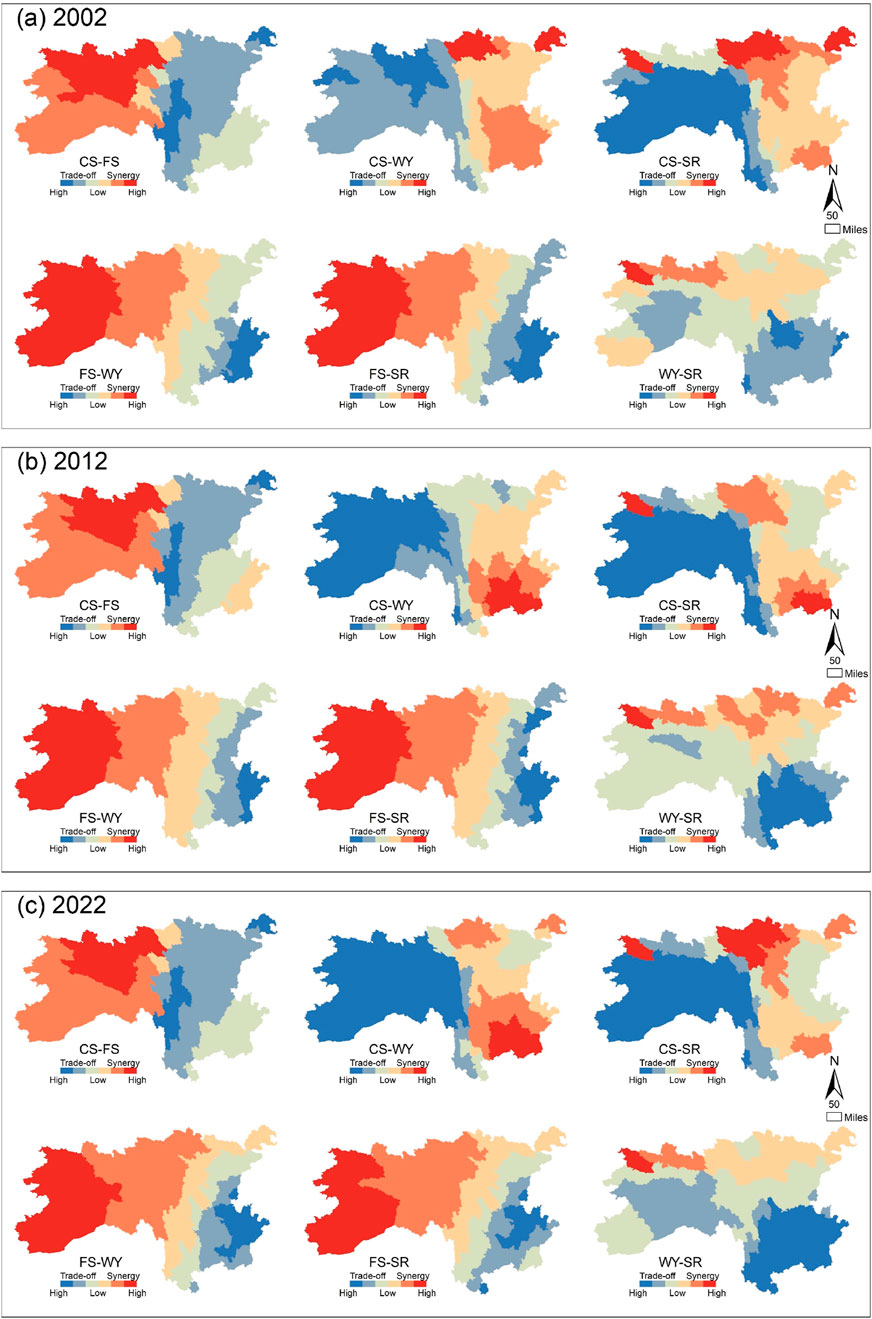
Figure 6. Spatial patterns of trade-offs and synergies among ESs in the Southwest Alpine Canyon Area from top to bottom: (a) 2002, (b) 2012 and (c) 2022. Note: CS-FS, carbon sequestration and food supply; CS-WY, carbon sequestration and water yield; CS-SR, carbon sequestration and soil conservation; FS-WY, food supply and water yield; FS-SR, food supply and soil conservation; WY-SR, water yield and soil conservation.
3.3 Mechanisms driving ecosystem services trade-offs and synergies
3.3.1 Explanatory power of natural factors and socio-economic factors
The study assessed the explanatory power of drivers affecting trade-offs and synergies among ecosystem services, and used q-statistic to identify dominant drivers (Figure 7). In 2002, elevation was the primary driver for the vast majority ESs trade-offs and synergistic pairs, while slope degree dominated CS-SR. Temperature ranked second for CS-FS and WY-SR. GDP was the second most influential factor for CS-WY, and population density was the second most important for FS-WY and FS-SR. In 2012, elevation remained the primary factor for CS-FS, while temperature emerged as the dominant driver for CS-WY and WY-SR. Slope degree continued to lead CS-SR, and population density became the primary factor for FS-WY and FS-SR. In 2022, elevation retained its dominance for most ESs trade-offs and synergistic pairs. Secondary industry became the primary factor for CS-SR, and temperature was the most influential for WY-SR. Temperature ranked second for CS-FS, population density was the second most important for CS-WY, FS-WY, and FS-SR, slope degree was the second most significant for CS-SR, and elevation was the second most important for WY-SR.
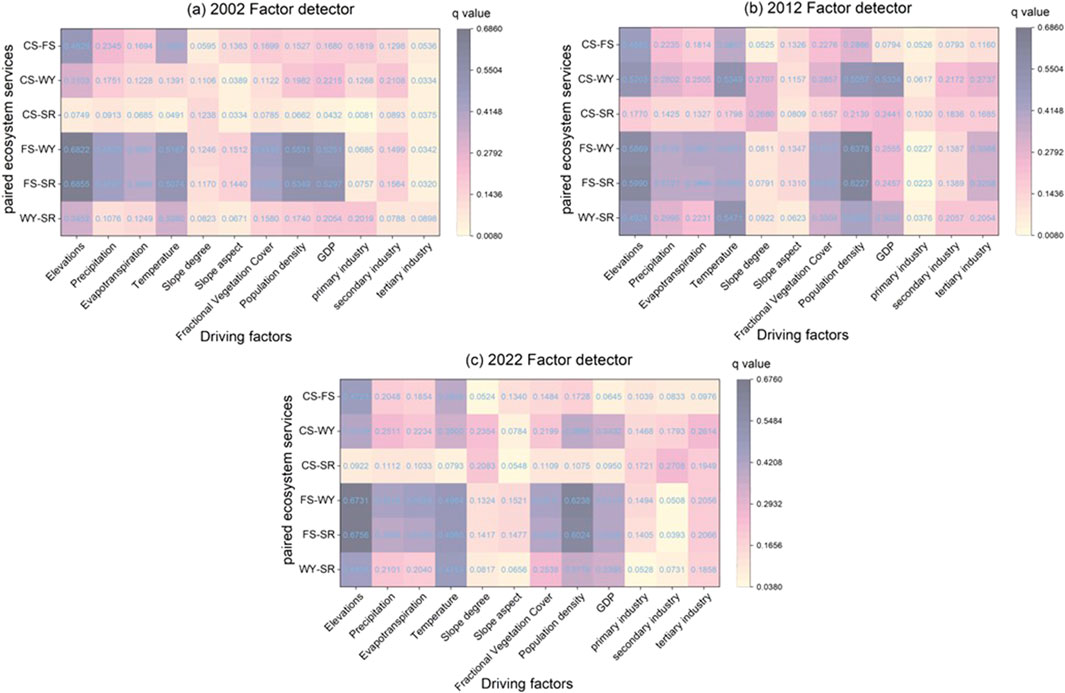
Figure 7. Factor detection results revealing the effects of factors on trade-offs and synergies between ESs. From top to bottom, respectively: (a) 2002 Factor detector, (b) 2012 Factor detector and (c) 2022 Factor detector. Note: CS-FS, carbon sequestration and food supply; CS-WY, carbon sequestration and water yield; CS-SR, carbon sequestration and soil conservation; FS-WY, food supply and water yield; FS-SR, food supply and soil conservation; WY-SR, water yield and soil conservation.
In summary, elevation consistently drove CS-FS dynamics, other ESs pairs exhibited temporal shifts in dominant factors, such as slope degree (2002–2012) and secondary industry (2022) for CS-SR. Furthermore, the trade-offs and synergies among ESs in the region are significantly influenced by a combination of natural and socio-economic factors, with elevation, slope degree, temperature, and population density playing pivotal roles.
3.3.2 Combination of interactions between natural factors and socio-economic factors
The results showed that the interactions between any two factors significantly enhanced explanatory power (Figure 8). During the study period, FS-WY and FS-SR interactions exhibited the highest sensitivity. In 2002, the interactions between elevation and slope degree, forest vegetation cover, tertiary industry exhibited the strongest explanatory power for CS-FS. For CS-WY, the interaction between slope degree and elevation, secondary industry, had significant influence. Forest vegetation cover and slope degree dominated CS-SR. The interactions between elevation and precipitation, evapotranspiration, and forest vegetation cover were the primary driver combinations for FS-WY and FS-SR. Regarding WY-SR, the interaction between temperature and primary industry, tertiary industry was the most significant explanatory power. In 2012, elevation and slope degree, primary industry, and tertiary industry were the main interaction combinations for CS-FS. For CS-WY, slope degree and elevation, GDP and evapotranspiration, and temperature and precipitation were the primary combinations of explanatory power. Tertiary industry and slope degree exerted the most significant influence on CS-SR, while the interactions between elevation and population density, primary industry had the largest effect on FS-WY and FS-SR. The interactions between temperature and evapotranspiration, slope degree, primary industry, and tertiary industry were the primary driver combinations for WY-SR. In 2022, secondary industry and elevation were the most significant for CS-FS and CS-WY. Primary industry and elevation dominated CS-SR. The interaction between elevation and other factors constitutes the primary driver combination for FS-WY and FS-SR. Primary industry and temperature were the most influential for WY-SR.
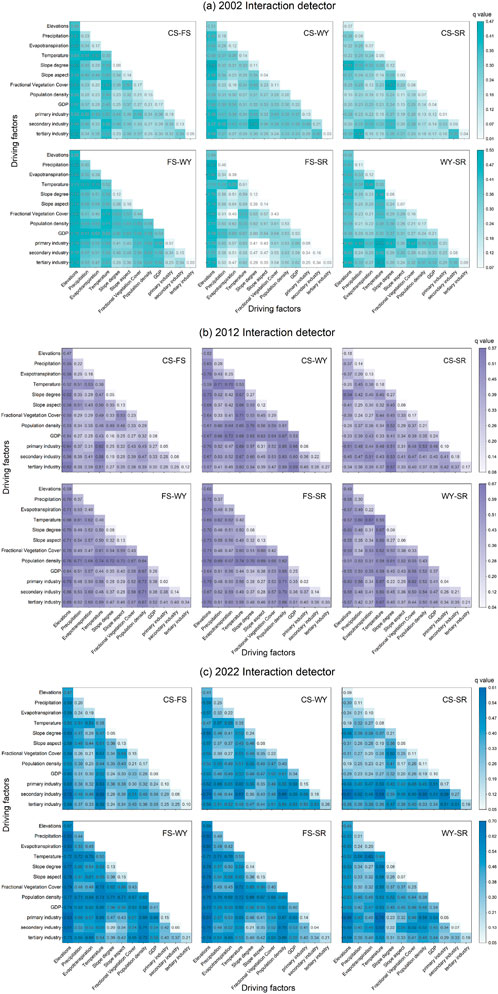
Figure 8. Interaction detection results of factors driving trade-offs and synergies between ESs from top to bottom: (a) 2002 Interaction detector, (b) 2012 Interaction detector and (c) 2022 Interaction detector. Note: CS-FS, carbon sequestration and food supply; CS-WY, carbon sequestration and water yield; CS-SR, carbon sequestration and soil conservation; FS-WY, food supply and water yield; FS-SR, food supply and soil conservation; WY-SR, water yield and soil conservation.
In summary, interactions were primarily characterized by two-factor enhancement or nonlinear enhancement, with no independent effects. In all ESs pairs, the interaction between elevation and other influencing factors represents the most critical driver combination.
4 Discussion
4.1 Ecosystem services in alpine canyon areas of Southwest China
Human survival is fundamentally dependent on the continuous provision of ecosystem services, and this dependence intensifies over time (Bennett et al., 2009). In the alpine canyon area of southwest China, carbon sequestration services provide the most significant ESs benefits. Areas with high carbon sequestration capacity are predominantly located in mountainous and hilly regions, where extensive natural and semi-natural forest landscapes serve as critical carbon sinks (Shen et al., 2020). Furthermore, the region’s high elevation and rugged terrain enhance humid airflow, resulting in abundant precipitation, while the elevated altitude reduces evaporation rates (Tan et al., 2024). These topographic and climatic characteristics collectively enhance the carbon sequestration potential and protective capacity of the Southwest Alpine Canyon. However, soil conservation and water yield services in this region have exhibited a decline, undermining their ecological functions (Aneseyee et al., 2020). Previous studies have indicated that water yield and soil conservation services tend to diminish when the forest area ratio exceeds a certain threshold (Pergams and Zaradic, 2008). To meet growing service demands, ecosystems are often transformed, either by reducing natural ecosystem areas or intensifying human energy inputs (Zhou et al., 2022). For instance, converting mountains and slopes for crop cultivation increases food supply but exacerbates soil erosion. Similarly, deforestation for agricultural expansion boosts food production but reduces biodiversity, water production, and soil retention capacity. To address these challenges, ecological protection must be prioritized during development, ensuring a balance between progress and conservation.
4.2 Dynamics of ecosystem service trade-offs and synergies
The relationships between ESs in the study area have changed over time. These changes are characterized by trade-offs and synergies, influenced by the diversity of ESs types, their uneven spatial distribution, and selective human utilization (Wang et al., 2024). These interactions are inherently complex (Schirpke et al., 2019), necessitating systematic analysis to clarify their dynamics and optimize ecosystem structure. In this study, trade-offs were observed between food supply and carbon sequestration, water yield, and soil conservation, consistent with findings from other regions. For instance, Raudsepp-Hearne and Peterson (2016) highlighted the importance of scale in ESs evaluation in the Richelieu and Yamaska basins of Canada, while Hao et al. (2023) identified similar trade-offs in the Qiantang River Basin in southeastern China. Additionally, significant synergies were observed for CS-WY, CS-SR, and WY-SR. These findings align with studies in the Beijing-Tianjin-Hebei region (Feng et al., 2021) and the Nile River Basin (Shifaw et al., 2024), which also reported synergies between CS, SR, and WY. The spatial heterogeneity of ESs trade-offs and synergies further underscores their complexity. For example, in the eastern part of the study area where precipitation is abundant, precipitation enhances wind erosion resistance and carbon fixation by regulating soil moisture and increasing vegetation coverage, fostering synergies between water production and carbon fixation services (Abera et al., 2021). However, arid and semi-arid areas in the western part of the study area, increased precipitation and soil moisture elevate evaporation rates, reducing surface temperatures and limiting vegetation photosynthesis in high-altitude cold areas (Xu et al., 2017; Tallis et al., 2008), resulting in a trade-off between water production and carbon fixation services. Understanding these dynamics provide a scientific foundation for regional land planning, biodiversity conservation, and ecological compensation.
4.3 Factors influencing ecosystem services trade-offs and synergies
The study explore the intrinsic mechanisms underlying changes in ESs trade-offs and synergies, and identify the natural and socio-economic factors influencing ESs trade-offs and synergies (Li et al., 2022; Liang et al., 2024; Yang et al., 2024). The results reveal that the trade-offs and synergies among ESs in the region are significantly influenced by a combination of natural and socio-economic factors, with elevation, slope degree, temperature, and population density playing pivotal roles. These factors are intricately interconnected, shaping the dynamics of ESs interactions in the region. Notably, in all ESs pairs, the interaction between elevation and other influencing factors represent the most critical driver combination. Mountainous areas, characterized by more complex topographic conditions than plains (Li et al., 2013), the effect of elevation is amplified by carrying greater elevation change per unit of horizontal distance and by the mountain range orientation interfering with atmospheric circulation. Widely varying elevation differences are common in the study area, leading to reorganization of hydrothermal conditions that directly determine vegetation types, soil development, and species distribution (Wang and Dai, 2020). These findings corroborate the conclusion that elevation are primary drivers of ESs trade-offs and synergies. Population density and GDP significantly explained ESs interactions, underscoring the regulatory role of human activities. Furthermore, the results indicate that two-factor enhancement and nonlinear enhancement dominated, emphasizing the critical role of factor interactions in shaping ESs dynamics (Bennett et al., 2009).
4.4 Sustainable development and research prospects
Ethnic minority communities in Southwest China have long inhabited the high-altitude alpine canyon areas, where limited production and construction land coexist with fragile ecosystems. These communities have accumulated substantial ecological wisdom, integrated into their traditional culture, which is crucial for the region’s sustainable development. This study conducted an in-depth analysis of ESs trade-offs and synergies in the alpine canyon, elucidating the mechanisms by which natural and human factors interact to shape ESs dynamics. This approach addresses the limitations of quantitative analyses in highly vulnerable and complex ecosystems, providing novel insights into ESs research in alpine canyons. By emphasizing the importance of individual factors and their interactions, as well as analyzing the spatial heterogeneity of ESs trade-offs and synergies, establishing development and protection priorities can inform optimal land use planning and policy measures. These measures support sustainable development, environmental protection, and regional planning in the Alpine Canyon area. Furthermore, this study offers scientific and technological support for ecological civilization policies and economic development in ethnic minority gathering areas of the China Southwest Alpine Canyon.
5 Conclusion
This study, utilizing multi-source datasets from the Southwest Alpine Canyon Area, quantitatively evaluate the spatiotemporal dynamics of key ESs - including carbon sequestration, food supply, water yield, and soil conservation - from 2002 to 2022. The trade-offs and synergies among ESs were quantified, and their spatial heterogeneity was systematically analyzed. Furthermore, the primary driving factors of ESs trade-offs and synergies, as well as the explanatory power of interactions among these factors, were identified. For the whole study area, carbon sequestration initially decreased and then increased. Water yield and soil conservation generally declined, with water yield showing more significant changes. Among all services, food supply exhibited the most significant increase, continuing to rise over the study period. A trade-off was observed between food supply and other ESs, with the most pronounced trade-off occurring between food supply and water yield. Spatially, this trade-off was predominantly distributed in the environmentally favorable alpine canyon regions of North Yunnan-Southwest Sichuan and Northwest Yunnan. In all ESs pairs, the interaction between elevation and other influencing factors represent the most critical driver combination. The trade-offs and synergies among ESs in the region are significantly influenced by a combination of natural and socio-economic factors, with elevation, slope degree, temperature, and population density playing pivotal roles. These factors are intricately interconnected, shaping the dynamics of ESs interactions in the region. These findings provide both valuable insights and theoretical foundations for the scientific management of ESs in the Southwest Alpine Canyon Area. By analyzing the trade-offs and synergies among ESs, this research identifies strategies to optimize resource utilization intensity, thereby reducing the vulnerability of both the environment and society to emergencies. Additionally, the study offers practical value for land use management in multi-ethnic gathering areas, as well as for enhancing ecological construction and environmental protection in key watersheds within the region.
Data availability statement
The original contributions presented in the study are included in the article/supplementary material, further inquiries can be directed to the corresponding author.
Author contributions
JJ: Investigation, Writing – review and editing, Conceptualization, Validation, Software, Methodology, Formal Analysis, Writing – original draft, Data curation, Visualization. JH: Funding acquisition, Project administration, Resources, Formal Analysis, Validation, Writing – review and editing, Conceptualization, Supervision. CZ: Funding acquisition, Project administration, Resources, Writing – review and editing. HF: Writing – review and editing, Resources, Data curation, Project administration, Investigation. YZ: Data curation, Investigation, Writing – review and editing.
Funding
The author(s) declare that financial support was received for the research and/or publication of this article. This research was supported by the National Key Research and Development Program of China (2022YFF1302905).
Conflict of interest
The authors declare that the research was conducted in the absence of any commercial or financial relationships that could be construed as a potential conflict of interest.
Generative AI statement
The author(s) declare that no Generative AI was used in the creation of this manuscript.
Publisher’s note
All claims expressed in this article are solely those of the authors and do not necessarily represent those of their affiliated organizations, or those of the publisher, the editors and the reviewers. Any product that may be evaluated in this article, or claim that may be made by its manufacturer, is not guaranteed or endorsed by the publisher.
References
Abera, W., Tamene, L., Kassawmar, T., Mulatu, K., Kassa, H., Verchot, L., et al. (2021). Impacts of land use and land cover dynamics on ecosystem services in the yayo coffee forest biosphere reserve, Southwestern Ethiopia. Ecosyst. Serv. 50, 101338. doi:10.1016/j.ecoser.2021.101338
Agudelo, C. A. R., Bustos, S. L. H., and Moreno, C. A. P. (2020). Modeling interactions among multiple ecosystem services. A critical review. Ecol. Modell. 429, 109103. doi:10.1016/j.ecolmodel.2020.109103
Aneseyee, A. B., Elias, E., Soromessa, T., and Feyisa, G. L. (2020). Land use/land cover change effect on soil erosion and sediment delivery in the winike watershed, omo gibe basin, Ethiopia. Sci. Total Environ. 728, 138776. doi:10.1016/j.scitotenv.2020.138776
Bennett, E. M., Peterson, G. D., and Gordon, L. J. (2009). Understanding relationships among multiple ecosystem services. Ecol. Lett. 12, 1394–1404. doi:10.1111/j.1461-0248.2009.01387x
Boithias, L., Acuña, V., Vergoñós, L., Ziv, G., Marcé, R., and Sabater, S. (2014). Assessment of the water supply: demand ratios in a Mediterranean Basin under different global change scenarios and mitigation alternatives. Sci. Total Environ. 470, 567–577. doi:10.1016/j.scitotenv.2013.10.003
Cord, A. F., Bartkowski, B., Beckmann, M., Dittrich, A., Hermans-Neumann, K., Kaim, A., et al. (2017). Towards systematic analyses of ecosystem service trade-offs and synergies: main concepts, methods and the road ahead. Ecosyst. Serv. 28, 264–272. doi:10.1016/j.ecoser.2017.07.012
Costanza, R., d’Arge, R., De Groot, R., Farber, S., Grasso, M., Hannon, B., et al. (1998). The value of the world's ecosystem services and natural capital. Ecol. Econ. 25, 3–15. doi:10.1016/S0921-8009(98)00020-2
Daming, H., Wenjuan, Z., and Yan, F. (2004). Research progress of international Rivers in China. J. Geogr. Sci. 14, 21–28. doi:10.1007/BF02841103
Da-ming, H., and Xuan-juan, L. (2001). Equitable utilisation and effective protection of sharing transboundary water resources: international Rivers of Western China. J. Geogr. Sci. 11, 490–500. doi:10.1007/BF02837978
Ding, Z., Jichun, T., Wenyong, T., Wang, K., Zhao, S., Song, W., et al. (2021). A graph theory into street network characteristics of the plain-type and the slope-type historical blocks: based on China's Southwestern regions. Fundam. Res., ISUF 2020 Virtual Conf. Proc. 104, 110. doi:10.1016/j.fmre.2021.02.002
Donohue, R. J., Roderick, M. L., and McVicar, T. R. (2012). Roots, storms and soil pores: incorporating key ecohydrological processes into Budyko’s hydrological model. J. Hydrol. 436, 35–50. doi:10.1016/j.jhydrol.2012.02.033
Feng, Z., Chen, T., and Wu, J. (2021). Understanding trade-offs and synergies of ecosystem services to support the decision-making in the beig-tian-hebei region. Land Use Policy 106, 105446. doi:10.1016/j.landusepol.2021.105446
Fu, B. J., and Yu, D. D. (2016). Trade-off analyses and synthetic integrated method of multiple ecosystem services. Resour. Sci. 38, 1–9. doi:10.18402/resci.2016.01.01
Guo, B., Yang, F., Fan, Y., and Zang, W. (2023). The dominant driving factors of rocky desertification and their variations in typical mountainous karst areas of southwest China in the context of global change. Catena 220, 106674. doi:10.1016/j.catena.2022.106674
Hall, G. L., Thompson, B. R., Stanojevic, S., Abramson, M. J., Beasley, R., Coates, A., et al. (2012). The global lung initiative 2012 reference values reflect contemporary Australasian spirometry. Respirology 17, 1150–1151. doi:10.1111/j.1440-1843.2012.02232x
Hao, X., Yuan, S., and Prishchepov, A. V. (2023). Spatial-temporal heterogeneity of ecosystem service interactions and their social-ecological drivers: implications for spatial planning and management. Resour. Conserv. Recy. 189, 106767. doi:10.1016/j.resconrec.2022.106767
Kupfer, J. A., and Farris, C. A. (2007). Incorporating spatial non-stationarity of regression coefficients into predictive vegetation models. Landsc. Ecol. 22, 837–852. doi:10.1007/s10980-006-9058-2
Li, J. H. (2010). The cultural interpretation of southwest settlement patterns. Chongqing: Chongqing University.
Li, S. C., Zhang, C. Y., Liu, J. L., Zhu, W. B., Ma, C., and Wang, J. (2013). The tradeoffs and synergies of ecosystem services: research progress, development trend, and themes of geography. Geogr. Res. 32, 1379–1390. doi:10.1111/geor.12016
Li, Y., Zeng, C., Liu, Z., Cai, B., and Zhang, Y. (2022). Integrating landscape pattern into characterising and optimising ecosystem services for regional sustainable development. Land 11, 140. doi:10.3390/land11010140
Liang, S., Yang, F., Zhang, J., Xiong, S., and Xu, Z. (2024). Assessment and management zoning of ecosystem service trade-Off/Synergy based on the social-ecological balance: a case of the chang-zhu-tan metropolitan area. Land 13, 127. doi:10.3390/land13020127
Lin, L., and Gui, Y. (2024). Traditional culture of settlements associated with the natural environment: the case of yi minority southwest China. J. Asian Archit. Build. Eng. 24, 2411–2429. doi:10.1080/13467581.2024.2373822
Mueller, A. H., Szymanowski, L., Wallon, S., Gao, B. W., and Yuan, F. (2016). Sudakov resummations in mueller-navelet dijet production. J. High. Energy Phys. 2016, 96–24. doi:10.1007/JHEP03(2016)096
Peng, J., Hu, X. X., Zhao, M. Y., Liu, Y., and Tian, L. (2017). Research progress on ecosystem service trade-offs: from cognition to decision-making. Acta Geogr. Sin. 72, 960–973. doi:10.11821/dlxb201706002
Pereira, H. M., Martins, I. S., Rosa, I. M., Kim, H., Leadley, P., Popp, A., et al. (2024). Global trends and scenarios for terrestrial biodiversity and ecosystem services from 1900 to 2050. Science 384, 458–465. doi:10.1126/science.adn3441
Pergams, O. R., and Zaradic, P. A. (2008). Evidence for a fundamental and pervasive shift away from nature-based recreation. Proc. Natl. Acad. Sci. U. S. A. 105, 2295–2300. doi:10.1073/pnas.0709893105
Ramyar, R., Saeedi, S., Bryant, M., Davatgar, A., and Hedjri, G. M. (2020). Ecosystem services mapping for green infrastructure planning–the case of Tehran. Sci. Total Environ. 703, 135466. doi:10.1016/j.scitotenv.2019.135466
Raudsepp-Hearne, C., and Peterson, G. D. (2016). Scale and ecosystem services: how do observation, management, and analysis shift with scale-lessons from Québec. Ecol. Soc. 21, art16. doi:10.5751/es-08605-210316
Reid, W. V., Mooney, H. A., Cropper, A., Capistrano, D., Carpenter, S. R., and Chopra, K. (2005). Ecosystems and human well-being-Synthesis: a report of the millennium ecosystem assessment. Island Press. Available online at: https://research.wur.nl/en/publications/ecosystems-and-human-well-being-synthesis-a-report-of-the-millenn
Schirpke, U., Candiago, S., Vigl, L. E., Jäger, H., Labadini, A., Marsoner, T., et al. (2019). Integrating supply, flow and demand to enhance the understanding of interactions among multiple ecosystem services. Sci. Total Environ. 651, 928–941. doi:10.1016/j.scitotenv.2018.09.235
Shen, J., Tang, P., and Zeng, H. (2020). Does China's carbon emission trading reduce carbon emissions? Evidence from listed firms. Energy sustain. Dev. 59, 120–129. doi:10.1016/j.esd.2020.09.007
Shifaw, E., Sha, J., Li, X., Bao, Z., Ji, J., Ji, Z., et al. (2024). Ecosystem services dynamics and their influencing factors: synergies/tradeoffs interactions and implications, the case of upper Blue Nile basin, Ethiopia. Sci. Total Environ. 938. doi:10.1016/j.scitotenv.2024.173524
Tallis, H., Kareiva, P., Marvier, M., and Chang, A. (2008). An ecosystem services framework to support both practical conservation and economic development. Proc. Natl. Acad. Sci. U. S. A. 105, 9457–9464. doi:10.1073/pnas.0705797105
Tan, F., Lu, Z., and Zeng, F. (2024). Study on the trade-off/synergy spatiotemporal benefits of ecosystem services and its influencing factors in hilly areas of southern China. Front. Ecol. Evol. 11, 1342766. doi:10.3389/fevo.2023.1342766
Tomscha, S. A., and Gergel, S. E. (2016). Ecosystem service trade-offs and synergies misunderstood without landscape history. Ecol. Soc. 21, art43. doi:10.5751/ES-08345-210143
Tomscha, S. A., Sutherland, I. J., Renard, D., Gergel, S. E., Rhemtulla, J. M., Bennett, E. M., et al. (2016). A guide to historical data sets for reconstructing ecosystem service change over time. BioScience 66, 747–762. doi:10.1093/biosci/biw086
Wang, C., Ma, L., Zhang, Y., Chen, N., and Wang, W. (2022). Spatiotemporal dynamics of wetlands and their driving factors based on PLS-SEM: a case study in wuhan. Sci. Total Environ. 806, 151310. doi:10.1016/j.scitotenv.2021.151310
Wang, J., Wu, W., Yang, M., Gao, Y., Shao, J., Yang, W., et al. (2024). Exploring the complex trade-offs and synergies of global ecosystem services. Environ. Sci. Ecotech. 21, 100391. doi:10.1016/j.ese.2024.100391
Wang, Y., and Dai, E. (2020). Spatial-temporal changes in ecosystem services and the trade-off relationship in Mountain regions: a case study of hengduan Mountain region in southwest China. J. Clean. Prod. 264, 121573. doi:10.1016/j.jclepro.2020.121573
Wang, Z., Jiang, Q., and Jiao, Y. (2019). Traditional ecological wisdom in modern society: perspectives from terraced fields in honghe and chongqing, southwest China. Ecol. Wis. Theory Pract., 125–148. doi:10.1007/978-981-13-0571-9_8
Xu, S., Liu, Y., Wang, X., and Zhang, G. (2017). Scale effect on spatial patterns of ecosystem services and associations among them in semi-arid area: a case study in Ningxia hui autonomous region, China. China. Sci. Total Environ. 598, 297–306. doi:10.1016/j.scitotenv.2017.04.009
Yahdjian, L., Sala, O. E., and Havstad, K. M. (2015). Rangeland ecosystem services: shifting focus from supply to reconciling supply and demand. Front. Ecol. Environ. 13, 44–51. doi:10.1890/140156
Yang, Y., Yuan, X., An, J., Su, Q., and Chen, B. (2024). Drivers of ecosystem services and their trade-offs and synergies in different land use policy zones of Shaanxi Province, China. J. Clean. Prod. 452, 142077. doi:10.1016/j.jclepro.2024.142077
Zhang, L., Guo, X., Li, J., Chen, Q., Wei, Y., and Zhao, X. (2020). Urbanization and its impact on ecosystem services: a review. Sustainability 12, 4725. doi:10.3390/s12114725
Zhao, R., Zhan, L., Yao, M., and Yang, L. (2020). A geographically weighted regression model augmented by geodetector analysis and principal component analysis for the spatial distribution of PM2.5. Sustain. Cities Soc. 56, 102106. doi:10.1016/j.scs.2020.102106
Keywords: southwest alpine canyon, ecosystem services, spatiotemporal patterns, trade-offs and synergies, geographically weighted regression model, driving mechanisms
Citation: Jiang J, Hou J, Zeng C, Feng H and Zhu Y (2025) Research on the driving mechanisms of ecosystem services in the alpine canyon areas of Southwest China. Front. Environ. Sci. 13:1617210. doi: 10.3389/fenvs.2025.1617210
Received: 24 April 2025; Accepted: 30 June 2025;
Published: 15 July 2025.
Edited by:
Pengcheng Hu, Commonwealth Scientific and Industrial Research Organisation (CSIRO), AustraliaReviewed by:
Kun Zhang, Nanjing Institute of Environment Science, ChinaChuan Yuan, Southwest University, China
Copyright © 2025 Jiang, Hou, Zeng, Feng and Zhu. This is an open-access article distributed under the terms of the Creative Commons Attribution License (CC BY). The use, distribution or reproduction in other forums is permitted, provided the original author(s) and the copyright owner(s) are credited and that the original publication in this journal is cited, in accordance with accepted academic practice. No use, distribution or reproduction is permitted which does not comply with these terms.
*Correspondence: Jian Hou, aG91amlhbkBiaWZ1LmVkdS5jbg==
 Jiahui Jiang
Jiahui Jiang Jian Hou
Jian Hou Chen Zeng
Chen Zeng Haobo Feng
Haobo Feng Yufan Zhu1
Yufan Zhu1